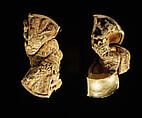A Pair of Royal Earrings
India (probably Andhra Pradesh)
Not on view
The place of these earrings in the history of Indian art is assured, not only for their intrinsic beauty but also because of the light they shed on the superb quality of goldsmithing early in this region. Early Indian statues of both male and female figures were usually portrayed wearing elaborate jewelry that sometimes seemed fanciful, since very little comparable jewelry from that period survives. The discovery of this pair of earrings provided the first tangible evidence that the jewelry depicted by sculptors was in fact based on real models, for a very similar pair is shown on a first century B.C. relief portrait of a "Universal Ruler" (chakravartin), from Jaggayapeta.
These earrings, judging from their material worth, excellence of craftsmanship, and use of royal emblems (a winged lion and an elephant) as part of their design, were most probably made as royal commissions. Each earring is composed of two rectangular, budlike forms growing outward from a central, double-stemmed tendril. The elephant and the lion of repoussé gold are consummately detailed, using granules, snippets of wire and sheet, and individually forged and hammered pieces of gold. The two pieces are not exactly identical: on the underside they are both decorated with a classical early Indian design of a vase containing three palmettes, but the patterning of the fronds differentiates them. They are so large and heavy that they must have distended the earlobes and rested on the shoulders of the wearer, like the pair worn by the "Universal Ruler."
Due to rights restrictions, this image cannot be enlarged, viewed at full screen, or downloaded.

